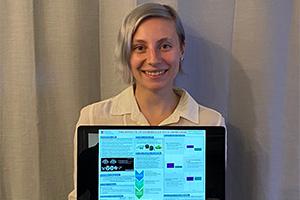Research
Robyn Rafferty Mathias Student Conference Moves Online April 18 scholarly and creative forum will be held remotely

Now in its 30th year, the Robyn Rafferty Mathias Student Research Conference is one of the College of Arts and Sciences’ most important forums for students to present their scholarship and creative works to faculty, judges, and peers.
This year, the conference planning was moving ahead as usual when the global COVID-19 pandemic began. Conference organizers reached out to participants and asked if they wanted the College to cancel, postpone, or host it remotely. The consensus was clear: students overwhelmingly wanted to move ahead and make the event a remote, virtual conference.
American University listened, and now more than 60 students have registered to participate remotely on April 18 via the video app Zoom. Approximately half of the students will present posters, and half will do panel discussions moderated by faculty.
For students who were looking forward to showcasing their hard work, the virtual conference has been a popular decision. “The Mathias Conference is one of the best opportunities at AU where neuroscience doctoral students like myself can share their research to students and faculty from other departments who might not normally hear about it,” says Marissa Marko (PhD Behavior, Cognition, and Neuroscience). Marko, pictured here, has prepared a research poster discussing the role the cerebellum plays in reading fluency. “The conference is great for sharing ideas and opening the doors to collaborating with other researchers,” she says.
A Different Experience
The conference will still feature its traditional two components: posters and panel discussions. The challenge, says CAS Director of Special Events Chelsey Anderson, was to figure out how to replicate this online to create the best possible experience for participants.
Anderson and organizers have divided the presentations into seven groups of students, each with a faculty moderator. Each student presenter will have 15 minutes to share a PowerPoint presentation. Judges will include graduate students, faculty, and staff to provide feedback and facilitate Q&A sessions.
The panels will run two hours each, but the conference participants can hop around from “room to room” says Anderson, just as they would be able to do in person. All in all, she observes, students are excited by the prospect of being “online lecturers” for the first time.
For the virtual poster presentations, all the posters will be screen-shared as PDFs, separated by theme, featuring faculty moderators who will curate one-hour Q&A sessions. The most exciting thing about the online aspect this year, says Anderson, is that the participants and judges can slowly flip through the posters and use chat boxes to ask questions and talk together as a group. There will be ongoing conversations between posters, judges, and the audience—something that’s sometimes difficult to facilitate during a live poster presentation.
A Chance to Build Valuable Skills
The new online format will showcase critically important skills, says Nathan Harshman, professor and chair of American University’s Department of Physics. “For all students, and maybe especially science students, showing that you can communicate and disseminate your research is really important when you apply to graduate schools or fellowships,” he says. “By holding this conference online, we are enabling our students to gain skills and demonstrate experiences that are valued by the community.”
Professor of Environmental Science Kiho Kim agrees. “Moving forward, remote/online conferences might become more common,” he says. “An opportunity to experience and get comfortable with communicating your work in an online environment can only be beneficial.”
